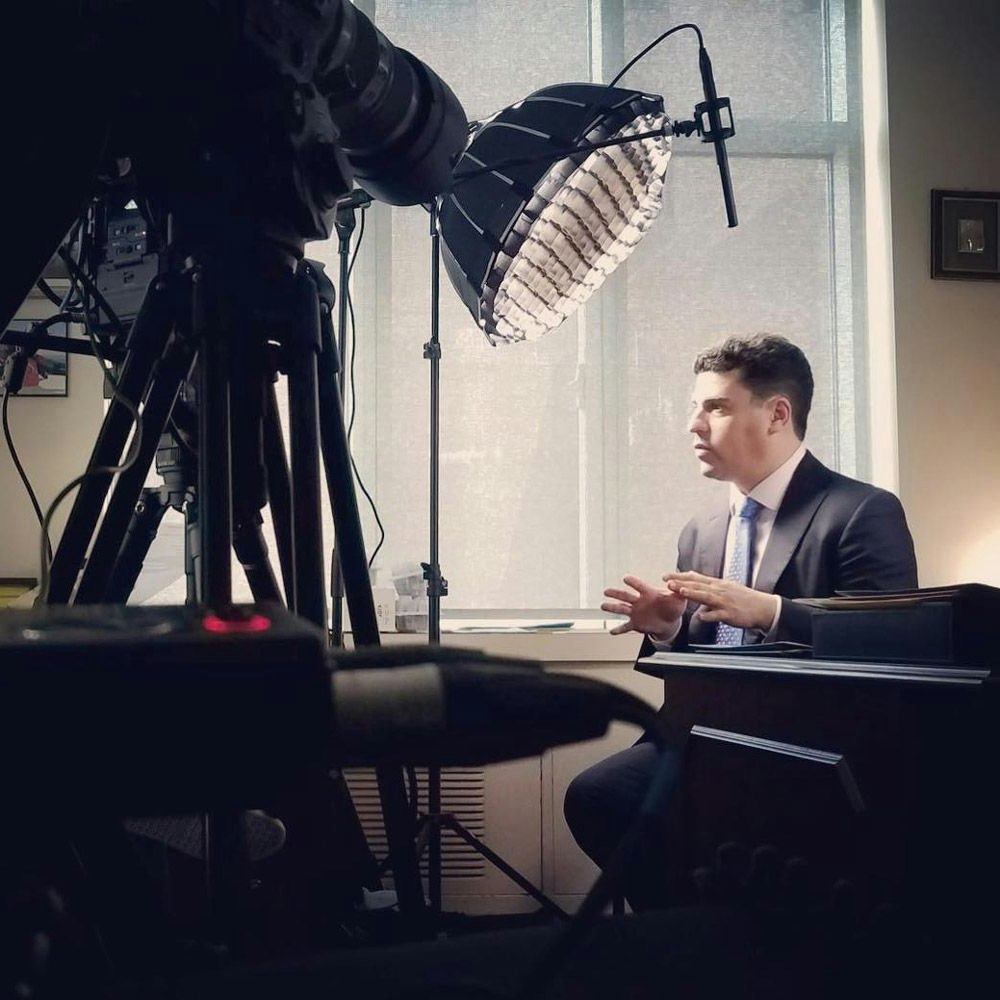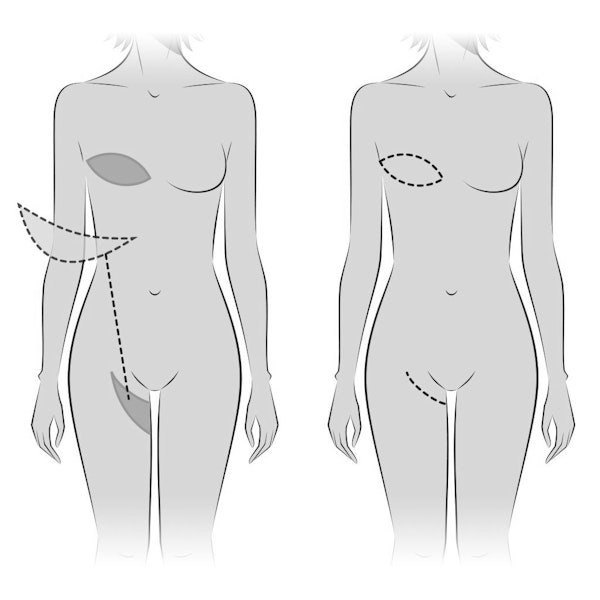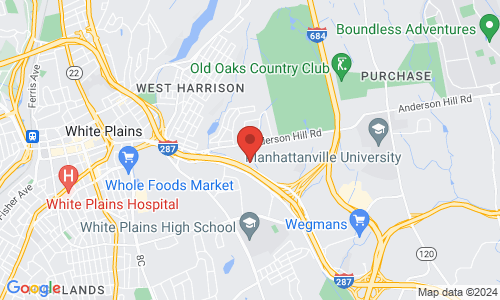
Natural Tissue Flap Reconstruction
Are you exploring breast reconstruction?
Natural tissue flap reconstruction is an alternative to breast implants that can give your breasts a more natural look and feel.
Dr. Oren Z. Lerman in Manhattan, NY, is an authority in breast reconstruction who can help you experience the benefits of this technique.
What is Natural Tissue Flap Breast Reconstruction? The Most Natural-Looking Breast Reconstruction
/
This form of breast reconstruction uses your natural (autologous) tissue rather than a breast implant to create a new breast. The tissue is typically taken from the abdomen, but can be harvested from other areas where there may be excess skin and fat. Since this form of breast reconstruction surgery uses your own tissue, it gives you results that look and feel like your natural breasts.
Types of Autologous Flap Reconstruction

Traditional Flap Reconstruction
The most common type of natural tissue breast reconstruction is a traditional flap surgery called transverse rectus abdominis myocutaneous (TRAM) flap reconstruction. The TRAM flap procedure involves taking autologous tissue from the abdomen and then tunneling it under the skin to the breast mound with its blood vessels still attached. The TRAM flap consists of skin, fat, blood vessels, and a portion of your rectus abdominis muscle. The removal of the muscle can lead to risks like abdominal wall weakness and hernias, so Dr. Lerman prefers a newer, more advanced method of flap surgery.

Microvascular Reconstruction
Microvascular (free flap) reconstruction is a surgically advanced form of breast reconstruction that completely separates the donor tissue from its original blood supply. This free flap is then transferred to the breast mound and attached to the existing blood vessels of the chest wall. Since it is detached from the original location, this allows the harvested tissue to be taken from one of several areas of the body, depending on the patient's needs and goals. Through this form of reconstructive surgery, Dr. Lerman can restore blood flow to the tissue flap and preserve the muscle of the abdominal wall.
Types of Free Flap Reconstruction
DIEP Flap
Deep inferior epigastric perforator (DIEP flap) reconstruction removes donor tissue from your abdomen then reattaches the blood vessels to your chest to create a new breast. DIEP flap offers the patient both natural-looking results and a reduced risk of side effects when compared to a TRAM flap. The DIEP flap procedure also has the added benefit of improved abdominal contours, similar to the results achieved with a tummy tuck.
SGAP Flap
Superior gluteal artery perforator (SGAP) flap reconstruction removes tissue from your upper buttock area then transfers that free flap to your chest to reattach the blood vessels and create your new breast.
Pap Flap
Profunda artery perforator (PAP) flap reconstruction harvests the fatty tissue from your inner thigh and transfers it to the breast mound, creating your new breast. PAP flap reconstruction also has the added aesthetic benefit of leaving you with slimmer upper thighs, similar to the effects of a thigh lift.
TUG Flap
Transverse upper gracilis (TUG) flap reconstruction is very similar to the PAP flap procedure. It takes tissue from the inner thigh to create your new breast. However, TUG flap harvests both fatty and muscle tissue from the donor area. This form of breast reconstruction also has the added benefit of a thigh lift.

Stacked Flap
This form of breast reconstruction uses a combination of two types of flaps to recreate one breast. This breast reconstruction is best for thin women who do not have enough tissue in a single donor area to recreate the breast. It is also great for creating larger breasts without the need for breast implants.
Trust Your Breast Reconstruction
To a Leading Plastic Surgeon

There are many options when it comes to breast reconstruction surgery. What may be right for some women may not be best for you and your needs. Dr. Lerman is a board-certified plastic surgeon who specializes in reconstructive breast surgery. He is the director of breast reconstruction at Lenox Hill Hospital's Institute for Comprehensive Breast Care, and also directs the microvascular breast reconstruction fellowship, training the next generation of breast reconstruction and DIEP flap experts.
Dr. Lerman performs more than 100 microvascular flap reconstruction procedures a year.
With his advanced knowledge, skills, and experience, he can recommend the type of breast reconstruction that will give you the most natural-looking and natural-feeling results. If you want to explore which type of breast reconstruction would be best for you, contact our Manhattan, NY, office and request a consultation with Dr. Lerman, a leader in the field of reconstructive breast surgery.
212-434-6980

Why Manhattan Chooses Dr. Lerman
After consulting with several physicians, I met with Dr. Lerman and immediately felt the most comfortable with his knowledge, experience, patience, ability to explain medical details and answer questions and overall bedside manner. I would highly recommend Dr. Lerman if you are selecting a plastic surgeon and want someone who cares about his patients as well as surgical outcomes...
View On GoogleDr Oren Lerman is not only a phenomenal and highly skilled surgeon but a fine and wonderful person as well, I was looking for a good surgeon for several months when another doctor suggested I see Dr Lerman. Meeting Dr Lerman for the first time was enough to convince me that he was the doctor I was looking for all along!...
View On GoogleAm I a Good Candidate For Natural Tissue Flap Reconstruction?
You may be a candidate for natural tissue flap reconstruction if you:
Are In Good Health
This form of breast reconstruction is major surgery, so you must be in good enough physical health to safely undergo the procedure. Breast cancer patients must be finished with radiation treatment or chemotherapy before having breast reconstruction.
Have Excess Tissue
While it is a common misconception that you must be overweight to have this type of breast reconstruction, there does need to be enough excess tissue in one or more areas for our surgeon to create a new breast mound.
Desire an Alternative to Breast Implants
Breast implant recipients will eventually need to have their implants replaced. Often, this is due to the natural aging process causing changes that no longer complement the implants in a way that looks natural or flattering. By using your own tissue instead of implants, you can achieve natural-looking results that age with you.
What to Expect During Natural Tissue Flap Reconstruction
By using autologous tissue, your new breasts will look, move, and feel like natural breasts.
Reach Out to Our Manhattan Office to Learn More About the Latest in Breast Reconstruction
Dr. Lerman is a leader in reconstructive and plastic surgery who mentors colleagues in the most advanced and effective techniques, including microvascular surgery. During a consultation, he can help determine if replacing your breast tissue with your own natural tissue during reconstructive surgery is a viable solution for you. Contact our Manhattan, NY, office to schedule a consultation, or give us a call at:
212-434-6980

"I'd Give 10 Stars if I Could"
Dr. Lerman helped save my foot after a severe compound calcaneus fracture. He did a muscle and artery transplant from my thigh and a skin graft. So thankful for Dr. Lerman and orthopedic Dr. Weiner for saving my foot. True professional. His staff is also very nice. I'd give 10 stars if I could.
View On GoogleDr. Lerman performed 3 surgeries on me as I had a bilateral mastectomy. He is just such an amazing physician, who cares about his patients. Dr. Lerman is warm, caring and attentive to every detail. I am beyond satisfied with the results of my surgeries.
View On GoogleThe Recovery After Natural Tissue Flap Reconstruction
/
Your recovery timeline will depend on which type of autologous breast reconstruction you have. For free flap reconstruction, you can plan on around 6-8 weeks before you can resume your regular activities and about one year for the scars to fade and your new breasts to be completely settled and healed. Because the traditional method of leaving the blood vessels of the donor tissue intact is more invasive, it involves a longer recovery.
Restoring Sensation With Nerve Grafts After a Mastectomy

"Dr. Lerman and His Staff Are Amazing!"
Dr. Lerman and his staff are amazing! I couldn’t be more satisfied with my results.
View On GoogleI couldn’t be happier with my results. Dr Lerman and his team were amazing!
View On Google








